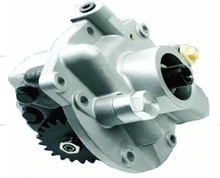Views: 0 Author: Site Editor Publish Time: 14-07-2025 Origin: Site








When it comes to maintaining industrial equipment, one of the most important aspects is ensuring that all components are functioning properly. Over time, pump parts wear out and need replacing to avoid performance issues, breakdowns, or inefficiencies. This leads us to a crucial question: How often should you replace pump parts? This is a vital concern for industries where pump systems are central to daily operations, such as manufacturing, water treatment, and oil & gas. Knowing when and how to replace your pump parts can prevent costly downtime and ensure that your systems operate at peak performance.
In this post, we will explore the key components of a pump, the signs that indicate it's time for a replacement, and the best practices for ensuring optimal performance of your pump system. Whether you're operating large-scale industrial pumps or smaller equipment, understanding when to replace pump parts is crucial for avoiding unnecessary repairs and maximizing efficiency.

Pumps are complex machines made up of several parts, each with a specific function to ensure smooth operation. These components often work under high stress and continuous use, meaning they naturally degrade over time. Regular maintenance and timely replacement of worn-out parts are essential for:
Maximizing Performance: As components age, they become less effective, leading to reduced pump efficiency. Replacing these parts ensures the pump continues to operate at peak performance.
Avoiding Downtime: Malfunctioning parts can cause unexpected downtime. By replacing parts regularly, you can prevent major issues that might stop production or lead to costly repairs.
Improving Safety: Worn-out pump parts can lead to leaks or failure, which might cause hazardous situations, especially in high-pressure systems. Regular replacements ensure safe operation.
Extending Equipment Lifespan: Taking care of your pump parts extends the life of your entire system. A well-maintained pump system can operate efficiently for many years, saving you money in the long run.
Understanding when to replace specific pump parts depends on the type of pump, its usage, and the materials being pumped. Here’s a breakdown of common pump components and recommended replacement intervals.
Seals and O-rings play a crucial role in preventing leaks and maintaining pressure. They ensure that fluids are contained within the pump system, preventing spills and maintaining optimal flow rates. Over time, seals can degrade due to chemical exposure, heat, or mechanical stress.
Replacement Interval: Seals and O-rings should typically be replaced every 6 months to 1 year, depending on the usage intensity and the type of fluid being pumped.
Regular inspection of these parts is essential, especially in systems dealing with corrosive or high-temperature fluids. A small leak can significantly reduce pump efficiency and result in higher operational costs.
The impeller is one of the most critical components in a pump. It’s responsible for transferring energy from the motor to the fluid, helping to move it through the system. Impellers are often subject to wear from the constant friction and impact of the fluid they move.
Replacement Interval: Impellers generally need replacing every 1 to 2 years, depending on the pump's operational environment. In abrasive conditions, impellers may require replacement more frequently.
If you notice a decrease in the flow rate or performance, it’s a clear sign that the impeller might be worn or damaged.
Bearings support the rotating parts of the pump and reduce friction. Over time, bearings can wear out, leading to vibrations, noise, or even failure of the pump motor.
Replacement Interval: Bearings should typically be replaced every 2 to 3 years, but this can vary depending on the pump's workload and operating conditions.
If you experience unusual noises or vibrations, it’s important to check the bearings immediately to prevent further damage.
The shaft sleeve protects the pump shaft from damage caused by abrasion and corrosion. In high-stress applications, shaft sleeves can wear out quickly, leading to shaft damage if not replaced promptly.
Replacement Interval: Shaft sleeves should be replaced every 1 to 2 years, or sooner if there’s significant wear visible.
Regular monitoring of shaft condition and sleeve integrity is critical to maintaining pump performance.
Gaskets form seals between two pump components to prevent leaks. As with seals and O-rings, gaskets can degrade due to temperature fluctuations, chemical exposure, and constant stress.
Replacement Interval: Gaskets should be replaced at least once a year, or sooner if they show signs of wear such as cracks, deformation, or leaks.
Maintaining the integrity of gaskets is essential to avoid any leakage of pumped fluids, which could not only waste valuable resources but also pose environmental or safety risks.
Check valves ensure that the fluid only flows in one direction, preventing backflow that could damage the pump or cause contamination. These valves are especially important in systems with multiple pumps or when dealing with sensitive fluids.
Replacement Interval: Depending on the frequency of use, check valves should be replaced every 1 to 3 years.
If backflow occurs or you notice that the system isn’t holding pressure, it’s likely time to replace the check valve.
Pump casings enclose and protect the internal components of the pump, allowing fluid to pass through in a controlled manner. Over time, pump casings may develop cracks, corrosion, or other forms of damage.
Replacement Interval: Pump casings should be inspected annually, and replaced when significant damage is found. In environments with corrosive fluids, replacement intervals may be shorter.
Regular checks for corrosion, cracks, or wear are essential to maintain the integrity of the pump casing.

Regular replacement of pump parts is essential, but so is proper maintenance. By following these tips, you can improve the efficiency and lifespan of your pump system:
Lubrication: Ensure that moving parts, such as bearings, are properly lubricated to reduce wear and friction.
Cleaning: Regularly clean your pump and its components to prevent debris build-up that could impede performance.
Monitoring: Implement a monitoring system to track the performance of your pumps. This can help you identify when a part may need to be replaced before it causes a breakdown.
By maintaining a routine of regular inspections and preventive maintenance, you can extend the life of your pump system and avoid unnecessary costs associated with repairs and replacements.
At JOC Machinery, we provide a wide range of high-quality pump parts designed to keep your systems running efficiently. Whether you need seals, impellers, bearings, or check valves, our parts are engineered for reliability and performance. Our commitment to quality ensures that you can replace your worn-out components with confidence, knowing that they’ll perform as expected and help extend the life of your pump system.
By choosing JOC Machinery’s products, you’re not just investing in high-quality parts; you’re investing in the continued success of your operations. Our team is dedicated to providing you with the support and solutions you need to maintain optimal pump performance.
Knowing when to replace pump parts and maintaining a regular replacement schedule is essential for keeping your pump systems operating at peak performance. Regularly replacing key components like seals, impellers, and bearings will prevent downtime, improve efficiency, and extend the life of your equipment. With the right parts and maintenance practices, you can ensure that your pump systems run smoothly, reduce operational costs, and avoid costly repairs.
At JOC Machinery, we offer a comprehensive range of pump parts to support your operations. By choosing our reliable and durable parts, you can maintain the efficiency and longevity of your pump systems. Visit our website to explore our full range of products and find the right components for your needs.
A: Seals should be replaced every 6 months to 1 year, depending on the usage intensity and the type of fluid being pumped.
A: If you notice a reduction in flow rate or the pump’s efficiency, the impeller may be worn and need replacement.
A: Bearings support the rotating parts of the pump. If they wear out, they can cause vibrations, noise, or even pump failure. Replacing them every 2 to 3 years is essential.
A: Regularly clean your pump components, lubricate moving parts, and check for signs of wear or corrosion. In harsh environments, replace damaged parts promptly.
A: JOC Machinery provides a wide range of durable and high-performance pump parts. Visit our website to explore our products and find the right parts for your needs.
Our OEM Stainless Steel/Brass CNC Machining Mid-Size Pneumatic Valve Body is engineered for precise flow control in pneumatic systems used across industrial automation, energy, and manufacturing sectors. Manufactured in Jiangsu, China, this valve body is available in premium stainless steel or brass to suit different environmental and performance requirements. With ±0.05 mm tolerance, every component meets stringent quality standards for durability and operational reliability.
The CB310 Custom Slewing Drive is engineered for solar power tracking systems and other industrial applications that require smooth, precise rotational control. Designed and manufactured in Jiangsu, China, this slewing drive integrates a single-row cross roller bearing for maximum stability, and is compatible with either DC motors or hydraulic motors, depending on your project requirements. With diameters ranging from 200 mm to 4000 mm, this drive is suitable for a wide range of solar panel arrays and mechanical systems.
Add: 20/FL., 26 North Zhongshan Road, Nanjing, Jiangsu, China
Tel: 0086-25-83317070
Fax: 0086-25-83303377
E-mail: peter@jocmachinery.com


